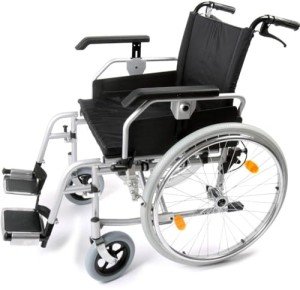Bariatric Wheelchair Seat Width
Seat Width
Having the appropriate seat width is very important to wheelchair users who invest longer durations in their chairs. Too narrow a seat will cause pressure on the hips and thighs which might result in sores or pressure points. Having too broad a seat can likewise make it hard for the user to reach the hand rims to propel themselves or maneuver in little areas.
To determine the correct seat width an individual would sit on a chair typically and have their measurement taken throughout their lap at the best point which is generally their hips. A wheelchair determining tape can be utilized to determine this, but a backyard stick is chosen as it avoids individuals from wrapping the tape around their hips which would provide an incorrect result.
The standard wheelchair seat width is 16" (narrow grownup), 18" (standard adult), and 20" (large adult). For bariatric clients, a 24" seat is available. This durable extra large bariatric wheelchair from Medline includes swing-away footrests, a carbon steel frame with rust- and chip-resistant chrome plating, and easy-to-clean vinyl upholstery. It has a weight capacity of 500 pounds.
Seat Depth
Generally, the seat depth of a bariatric wheelchair was added 2" to the measurement taken at the user's best point (typically their hips). This was suggested to accommodate extra layers of clothes that may be used throughout cold weather condition. Nevertheless, this practice is ending up being less common as wheelchair users are able to invest more time indoors and are not using long coats. This makes the seat depth of a chair less important when picking a bariatric wheelchair. However, it is still crucial to select an alternative that provides sufficient support for larger users.
The Medline folding additional broad bariatric manual wheelchair includes a comfortable 24" seat width and a sturdy slide tube silver vein frame. It also has an adjustable axle and tool-free elevating legrests.
Seat Height
When it pertains to figuring out the right wheelchair seat width you should constantly measure from the user's widest point which is usually their hips. bariatric aids will likewise need to think about whether the user is going to be using a winter coat as this might add 2" to the width required.
When a wheelchair is in usage it should just be operated on level surface areas with the wheel locks totally engaged. This is to avoid the chair from having the ability to move slopes that are 10 degrees or greater. It is also important to bear in mind that any activity that might shift the center of gravity in the chair ought to be made with care. This consists of reaching for products that need the individual to lean out of their seat or trying to stand from it.
Whenever you have the chair in use it is advised that you routinely examine it for damage and lube any areas that are deemed needed. For instance, the casters should be lubricated by getting rid of the caster fork and using a multi-purpose grease to use to the caster stem bearings. Also, the foot plates can be changed by loosening the bolt and after that moving them to the desired position. This enables the feet to sit comfortably on the footplate and prevents any pressure points from forming. This can be very uneasy for the user and if left ignored, can result in push sores.
Weight Capacity
Bariatric wheelchairs are created to support more weight than standard wheelchairs. This makes them tougher and better equipped to manage falls. They are likewise typically larger and broader, making them less maneuverable in tight spaces than basic wheelchairs. They require automobiles with unique ramps and lifts to load them, as well as motorists who understand how to best transport them from one location to the next.
When picking a wheelchair, consider its weight capacity as it will be the primary determining element in whether it will accommodate your passenger's needs. The weight capacity of the chair is typically listed as a static load, meaning that it indicates the amount of weight the chair can easily hold while standing still. Nevertheless, some producers likewise list an active load that is based upon a drop test and can replicate the result of someone sitting down in the chair. This may be a more reputable measurement of the weight limit, depending on your requirements.

If you plan to carry out activities that move your center of mass in the seat (such as grabbing items), make certain to have front casters pointed in a forward direction and wheel locks engaged so the chair will not topple. Also, examine that casters are lubed routinely to avoid extreme wear and abrasions. The lubrication procedure includes removing the fork, separating the caster from the wheel, and greasing the caster stem bearings with high-quality multi-purpose grease.
